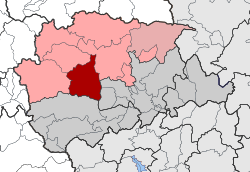Kleino
Kleino
Κλεινό | |
|---|---|
| Coordinates: 39°40′N 21°27′E / 39.667°N 21.450°E | |
| Country | Greece |
| Administrative region | Thessaly |
| Regional unit | Trikala |
| Municipality | Meteora |
| Area | |
| • Municipal unit | 180.7 km2 (69.8 sq mi) |
| Population (2021)[1] | |
| • Municipal unit | 1,197 |
| • Municipal unit density | 6.6/km2 (17/sq mi) |
| • Community | 328 |
| Time zone | UTC+2 (EET) |
| • Summer (DST) | UTC+3 (EEST) |
| Vehicle registration | ΤΚ |
Kleino (Greek: Κλεινό; formerly Klinovos, Aromanian: Clinova[2]) is an Aromanian[3] village and a former municipality in the Trikala regional unit, Thessaly, Greece. Since the 2011 local government reform it is part of the municipality Meteora, of which it is a municipal unit.[4] The municipal unit has an area of 180.728 km2.[5] Population 1,197 (2021).
The Monastery of the Holy Apostles is located in Kleino. It contains a unique old inscription in the Aromanian language.[6]
History
[edit]Based on the codex of the monastery of Varlaam in Meteora, the village seems to have existed already in the 10th century.[7] The settlement is mentioned as Klinovista in a document of 1340, so it is a settlement of the Byzantine era. In the Turkish census of 1454/55, as Klinova, it is mentioned among the honorary Trikala spahs. In Turkish sources it is referred to as Klinovos, Klinovon, Klinovous and also as Klinovopolis.[8]
The settlements that made up Kleinovo seem to have been inhabited throughout the Turkish occupation and it is also mentioned as the place of origin of the Vlach-speaking Patriarch of Constantinople, Matthew II (1596-1602). He also mentions the Bishop of Stagios, Silivria and later of Philippou as the place of origin of Paisios II (1740-1822). During the time that Paisios was bishop of Stagios, the church of the monastery of the Holy Apostles, where we find his autobiography frescoed, as well as the churches of Agia Paraskevi and Aghios Georgios, were hagiographed under his care. In addition, the Patriarch of Alexandria Jerome Ierotheos I and the revolutionary fighter,[9] charioteer of the region of Aspropotamos, Gregorios Liakatas (1795-1825), descended from the village.
Notable people
[edit]- Grigoris Liakatas (1795–1826), fighter and klepht
References
[edit]- ^ "Αποτελέσματα Απογραφής Πληθυσμού - Κατοικιών 2021, Μόνιμος Πληθυσμός κατά οικισμό" [Results of the 2021 Population - Housing Census, Permanent population by settlement] (in Greek). Hellenic Statistical Authority. 29 March 2024.
- ^ Studii istorice asupra aromânilor din Peninsula Balcanică. p. 124.
- ^ Transhumants and Rural Change in Northern Greece Throughout the Nineteenth Century. p. 58.
- ^ "ΦΕΚ A 87/2010, Kallikratis reform law text" (in Greek). Government Gazette.
- ^ "Population & housing census 2001 (incl. area and average elevation)" (PDF) (in Greek). National Statistical Service of Greece. Archived from the original (PDF) on 2015-09-21.
- ^ Kalyvas, Grigoris G. (29 June 2015). "Ιερά Μονή Αγίων Αποστόλων Κλεινοβού – Ένα μικρό αφιέρωμα σε ένα από τα σημαντικότερα Θρησκευτικά μνημεία περιοχής Καλαμπάκας". Stagonnews (in Greek).
- ^ Κουκούδης, Αστέριος Ι. (2000). Μελέτες για τους Βλάχους. Vol. Β΄. Οι Μητροπόλεις και η Διασπορά των Βλάχων. Θεσσαλονίκη: εκδόσεις Ζήτρος. p. 91.
- ^ Terezakis, George. "Δημογραφική διερεύνηση στη Θεσσαλία κατά τον Ύστερο Μεσαίωνα".
{{cite journal}}: Cite journal requires|journal=(help) - ^ "Παΐσιος Βʹ: ο δραστήριος και φιλεκπαιδευτικός Κλινοβίτης ιεράρχης των Σταγών". www.vlioras.gr. Retrieved 2021-09-28.


